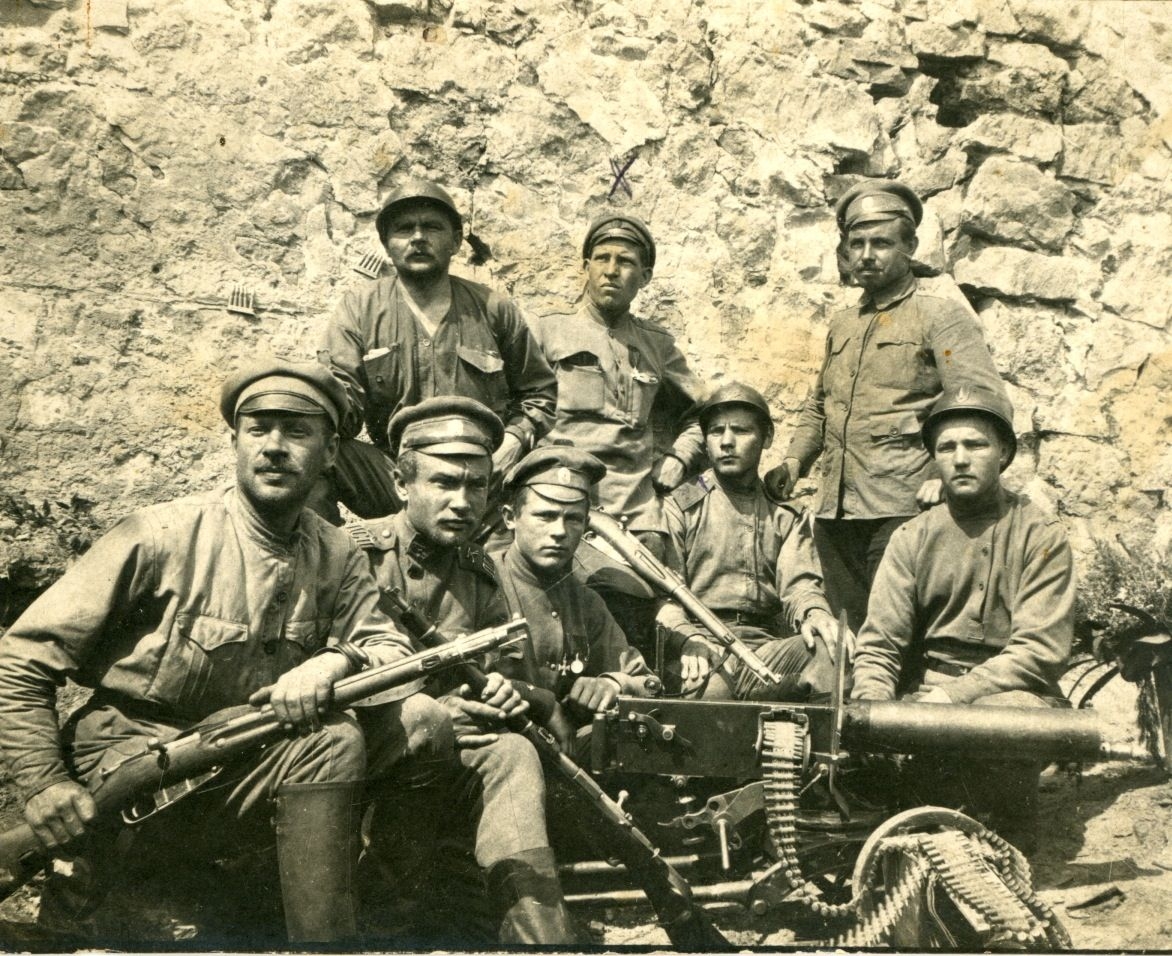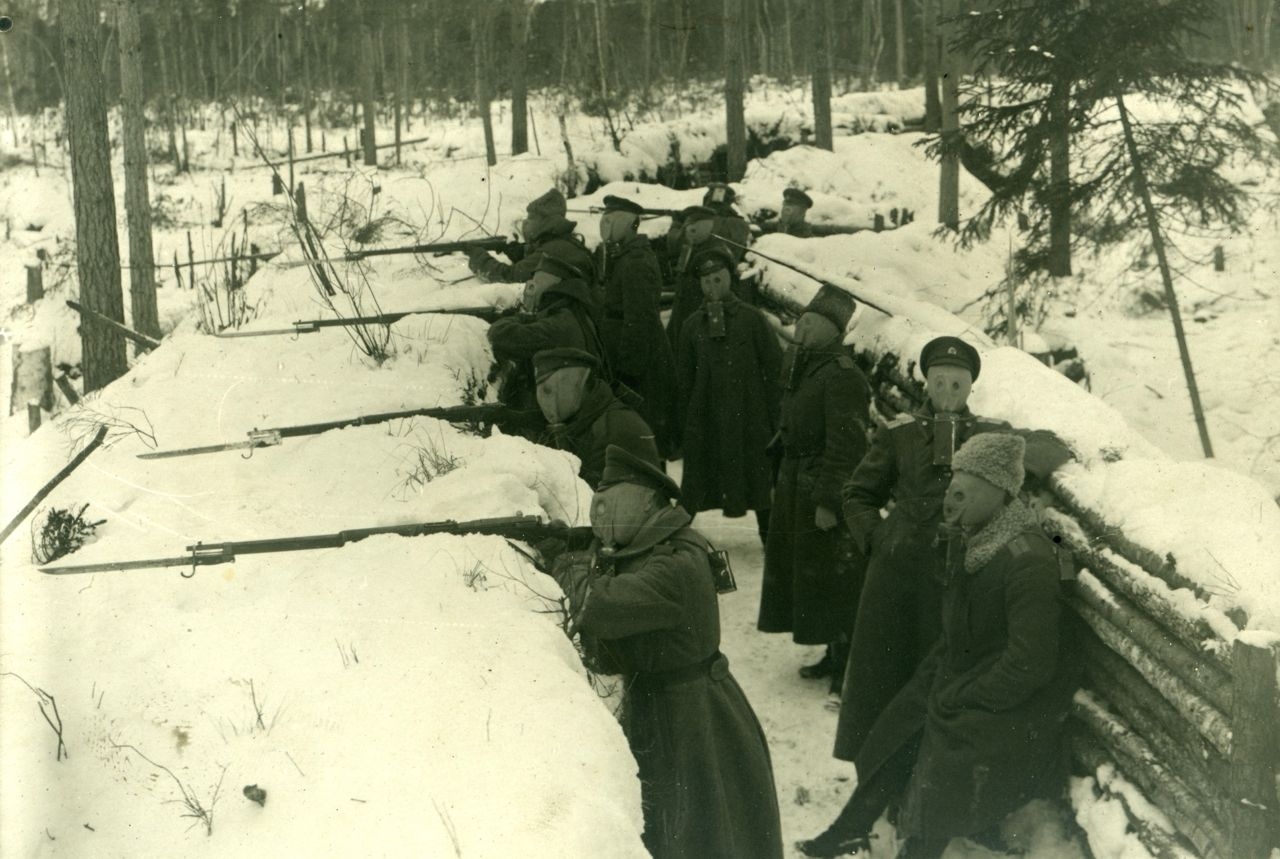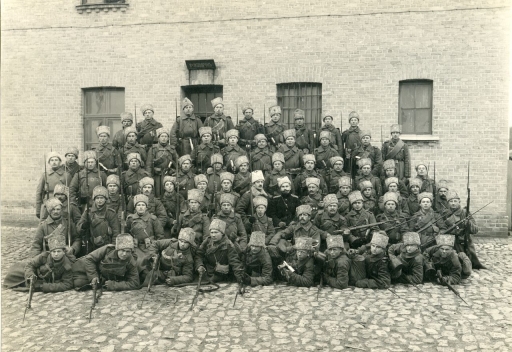Newly-formed Latvian units went into action with the Imperial Russian Army 100 years ago to resist a German push. CN contributor Patrick Gregory has recently visited the Baltic, and tells the story of how the Latvian Rifles carved out a reputation on the shifting battle lines of the Eastern Front.
If the Western Front had remained largely static for the majority of 1915 – in spite of the fierce fighting in the Artois sector, at Ypres and Loos and elsewhere – the vast swathe of territory which formed the Eastern Front had shown a more dynamic fluidity.
The cut and thrust of the year had begun in February with a corps of the Russian Imperial Army encircled in the Augustów forests east of the Masurian Lakes. The short, sharp campaign, initially launched by Below’s German 8th Army in the middle of a snowstorm, saw the four Russian divisions of the 20th Army Corps cut off and captured: a rout which matched that of the previous September at the Lakes and one which came as a further blow to Russian morale.
In Russia, the Imperial Command Stavka took stock, opting to hit back the following month further south in Galicia, capturing Przemyl as the ebb and flow continued across the front. Galicia, eastern Poland and modern-day Belarus and Lithuania would all witness a slew of battles in the months ahead.
Momentum
But whilst the Russians succeeded in frustrating German and Austro-Hungarian forces here and there, the momentum for the most part lay with the latter armies. By the end of August all Polish territory had been occupied by the Central Powers and 750,000 Russians taken prisoner.
The remainder of Russian forces retreated, the one crumb of comfort that they had made a relatively orderly redeployment into their heartland: the stop-start nature of the strategy adopted over the time by Falkenhayn, Ludendorff and Conrad meant that the Germans and Austrians had missed an opportunity to decisively break Russia’s ability to continue the First World War.
By October 1915 the Russian retreat had come to a halt along a line running from the Baltic Sea just west of Riga southward to Czernowitz on the Romanian border.
It is at this point in October and November 1915 that a small vignette might be glimpsed in the Baltic territories: only a side-story to the Eastern Front’s totality, yet a useful lens through which the Front’s dynamic might be viewed.

Soldiers of the 2nd Riga Latvian riflemen regiment’s machinegun unit in the trenches in 1917 (Image courtesy of the Latvian War Museum, Riga)
The story came from inside Latvia and acts as an episode which tells us something of the Russian Empire then and what it was to become and unfolded just behind where the Russian command had now drawn its line of defence near Riga. Latvia, as with other Baltic states, had long been under Russian control and its territories and people had been part of the war from the outset. Indeed only two days into the war German warships had opened fire on western Latvia – Courland or Kurzeme – on the coastal city of Liepaja.
Latvian nationals were part and parcel of the Russian Imperial Army and thousands of men had been part of the army corps crushed at the Second Battle of the Masurian Lakes; and even before that setback, in late 1914, German forces had descended on Jelgava, some 25 miles south-west of the Latvian ‘capital’ Riga. Jelgava held out for a period of time thanks to reinforcements – mainly Latvian – from the Daugavgriva Fortress in the north-west suburbs of Riga.
Jelgava
But with Jelgava’s collapse, and with the impending threat of the advancing German forces, permission was now sought for the formation of two specifically Latvian battalions. It was something of a controversial suggestion even in war-time. Such symbols of nationalist force and identity among the empire’s many constituent peoples was something which had hitherto been frowned upon and misgivings were heard in some Tsarist and military circles when the request was made.
But given the circumstances now facing the Stavka commanders, and given the hope that local volunteers in Latvia might fight for their homeland in a more concerted manner, the order was dispatched. A ‘Battalion Organising Committee’ was set up to recruit the new men and two battalions were quickly formed: the 1st (Daugavgriva) Rifles and the 2nd (Riga) Rifles. Many of the conscripts were young men aged between 17 and 20 and they were drawn initially from Riga and its surrounding area but the momentum soon increased.
Six more battalions were added, the units drawing on the Latvian diaspora in Estonia and Russia, with the names of the units – Kurzeme, Vidzeme, Zemgale – reflecting their provinces and peoples. Eight thousand men were soon registered but in order to further make up the battalion numbers, with more than 1,200 men and Latvian officers needed per unit as well as a reserve battalion, fellow nationals were co-opted in from existing armies. It wasn’t long before they were pressed into service, an opportunity to prove themselves in the field.
Surge
A sudden surge by German forces in late October 1915 against the Russian 12th Army saw three of the Rifle battalions sent out to meet them. This, their first encounter, came on 25th October at Lake Babite just west of Riga and the second further west at Sloka with fighting spilling over into November.
These first skirmishes were in truth just that: comparatively minor actions and more the work of reconnaissance units than anything else. But once favourably reported in Petrograd and Moscow they served to build a reputation for the new Latvian battalions. That reputation grew in stature in encounters the following spring and summer as the 12th Army sought to drive the besieging forces back from Riga’s arterial Daugava river and the Riflemen also caught the eye of the British Military Mission in Petrograd. One of the Mission’s officers, Major Cuthbert Thornhill, was sent to Riga to talk to them.
The Allies were keen to impress on the Russians the need to keep German forces occupied on the Eastern Front, to prevent their relocation west. In order to satisfy that demand, Russian commanders in the area increasingly turned to the Latvian Rifles for tactical support and guidance, impressed not just by their battle prowess but their discipline and morale; and it was in part the Rifles’ showing in July 1916 – pinning the German 8th Army down in an otherwise inconclusive battle south of Riga – which prevented those forces being switched to the Western Front and aiding the German war effort, under pressure as they were from Britain and France on the Somme.
On 29th August 1916 the Latvian battalions fought as a combined brigade force of their own for the first time at Smarde west of Riga and afterwards the Russian Stavka decided to organise them into two official Rifles Brigades, the 1st and 2nd.

Soldiers of the 5th Zemgale Latvian riflemen regiment in the Tirelis swamp, winter 1916/1917 (Image courtesy of the Latvian War Museum, Riga)
However, the Latvians’ next major set piece operation was to prove a turning point, and not in a way or in a manner they might have hoped. The operation they were involved in took place south-west of Riga at Jelgava, the scene of the Latvians’ previous and well-regarded resistance some 18 months before. Now they were to attempt to break out of the enemy siege of their capital, yet it did not go according to plan. The operation – the ‘Christmas and January Battles’ – achieved none of its aims in spite of the Russian 12th Army’s numerical advantage.
A combined total of 184 battalions faced the German 8th Army’s sixty-six, with the Germans also outweighed in weaponry and cavalry, if possessing more heavy artillery. In the fighting which followed the Latvians quickly breached the German lines as they had in previous operations, penetrating several kilometres into enemy-held territory; but their participation was rendered little more than a costly failure in terms of lives lost.
Reinforcements from other units failed to materialise once they had made their breakthrough and, fighting in temperatures hovering between minus 25 C and minus 38 C, more than nine thousand Riflemen – nearly 40% of the force – perished. As the Riflemen retreated, leaving their dead in the snowy wastes around the Tirelis Swamp, a sense of betrayal overcame them.
Faltering
The Christmas and January battles were a harbinger of things to come for an already faltering Russian war effort. A last-ditch offensive led by General Kornilov against the Austrians in eastern Galicia in July 1917 turned into a rout and by October the advancing Germans had won control of Riga. A further German offensive in February-March 1918 saw them take over most of the rest of Latvia and move into territories in Livonia and Estonia up to the Gulf of Finland.
By that stage the Tsar had long departed the political stage; even the Provisional Government which had replaced Nicholas’ court had itself succumbed to Lenin’s Bolshevik revolution and Lenin now moved to bring a halt to the war. Yet the story didn’t end there for the Riflemen or their fellow countrymen.
The political upheaval which had gripped Russia in 1917 had rippled its way through the army and was to have a continuing effect on the Latvians’ story. Soldiers of the once Imperial Army began to elect their own councils and committees, with the Bolsheviks determined to split enlisted men from their officer corps.
In the case of the Latvians, Riflemen who only months previously had begun to sport symbols of their homeland and to fly the new red-white-red flag of their would-be nation, now fell began to fall under the influence of the Bolshevik Latvian Social Democrat Party and a political credo which espoused a more internationalist approach.
Soviets
A convention held by the Riflemen in late May 1917 adopted an official political position opposed to the war and in favour of soldiers’ and workers’ soviets. This new doctrine did not yet preclude the Riflemen and Siberian regiments from fighting, and doing so with some vigour, through the late summer; but their war effort, as with that of the 12th Army generally, began to crumble. With Riga’s fall the retreating Russian forces made east into Vidzeme region with a majority of the Army continuing on its way into Russia proper.
In time nearly 12,000 Latvian Riflemen found themselves in Russia with them as the anarchy unleashed by the revolution swirled fiercely around them. Some of the units, well regarded as they now were as soldiers, began to serve as an elite Praetorian guard for the new Soviet government in Petrograd. Others began to fight as delineated Soviet Latvian Rifle units, part of the Red Army in the subsequent Civil War, a number of them even seeing service on Latvian soil during those years.
Yet by the summer of 1920 the homeland many had originally taken up arms to defend had established itself as an independent country, the first such manifestation of the small Baltic republic in the 20th century.
Patrick Gregory is co-author with Elizabeth Nurser of ‘An American on the Western Front: The Letters of Arthur Clifford Kimber’ – to be published by The History Press in June 2016
All images courtesy of the Latvian War Museum/Latvijas Kara Muzejs Riga
© Centenary News & Author
